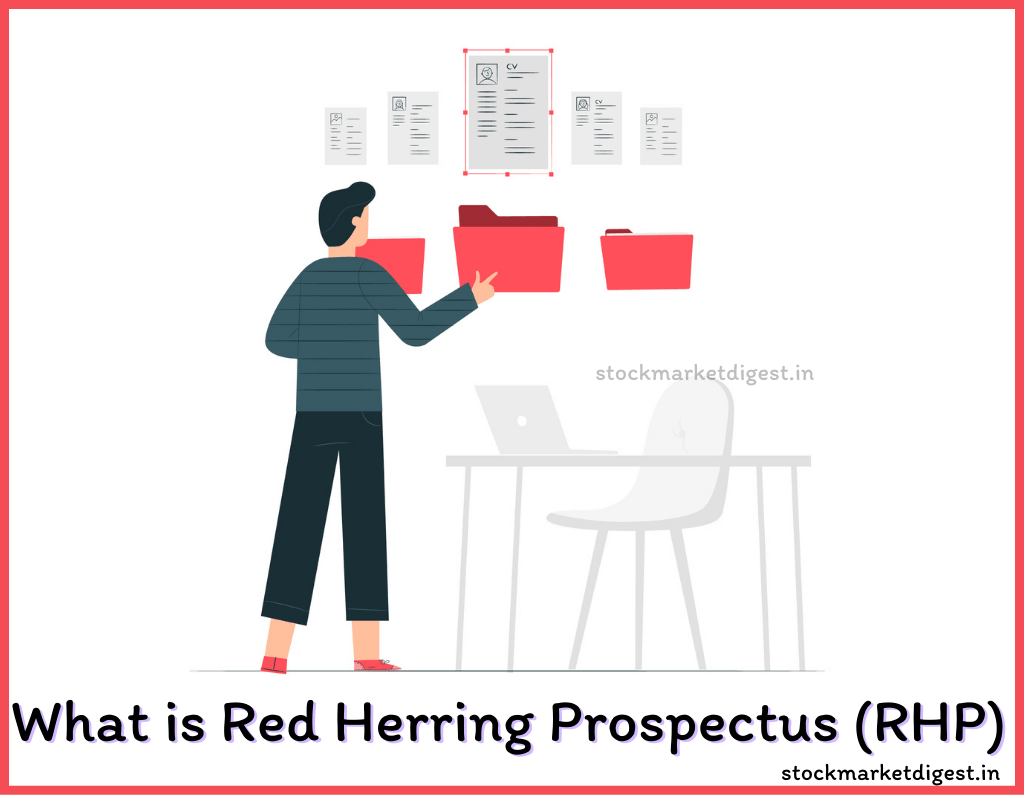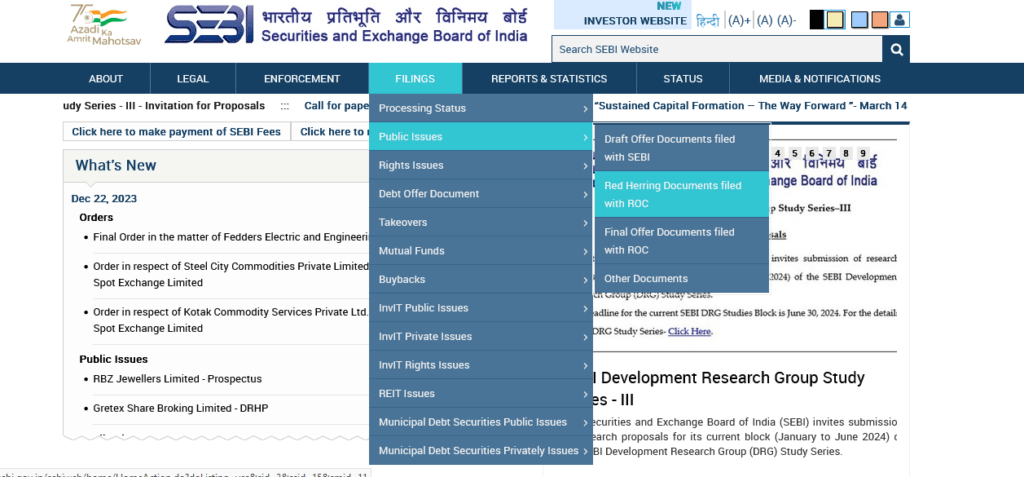The Securities and Exchange Board of India (SEBI) requires all companies planning to launch an Initial Public Offering (IPO) to provide specific details about their business, finances, risks, and more. This information is shared through a document known as the Red Herring Prospectus (RHP).
In this article, we’ll provide tips to help you read an RHP effectively and make well-informed decisions about investing in the company.

What is Red Herring Prospectus (RHP)?
A Red Herring Prospectus (RHP) is like a guidebook that companies use when they decide to share a piece of their ownership with the public for the first time through something called an Initial Public Offering.
It’s a bit like a company saying, “Hey, we want to invite you to be a part of our journey, and here’s some important information for you.”
This guidebook, or RHP, is a special document that talks about the company’s story, what they do, how they make money, and who is in charge. It’s a bit like introducing yourself to someone new but in writing.
The name “Red Herring” is a bit funny; it means that some details, like the exact price of the shares, are not final yet and are marked in red until everything gets approval.
Inside this guidebook, you can find out why the company wants to share its ownership, how it plans to use the money it gets from selling shares, and what challenges or risks might be there.
It’s a tool for everyday people who might be interested in becoming part-owners of the company to understand what they’re getting into.
So, in simple terms, an RHP is like a friendly invitation from a company, explaining what they do, why they’re asking for your support, and giving you a heads-up about anything important you should know before deciding to be a part of their big family.
Also Read : What is Draft Red Herring Prospectus?
Why is Red Herring Prospectus important for investors ?
The Red Herring Prospectus is like a map for people thinking about investing money in a company’s big family. It’s important because it tells you everything about the company – what they do, how they make money, and what plans they have.
Imagine it’s like checking a recipe before deciding to cook something new; the Red Herring Prospectus helps you see if the company is a good recipe for your investment. It talks about the company’s strengths, possible problems, and even how they plan to use the money they get from selling shares.
So, it’s a guide that helps you decide if the company is a good fit for your investment journey, giving you the scoop on what might go well and what might be tricky.
How to access Red Herring Prospectus ?
Accessing the Red Herring Prospectus is like finding a guidebook to understand a company’s story before deciding to invest. Here are simple steps to access it:

- SEBI’s Website:
- Visit SEBI’s official website (https://www.sebi.gov.in/).
- Look for the ‘Public Issues’ section on the filings page. There, you can find the RHPs and offer documents for upcoming IPOs.
- Newspaper Announcements:
- Companies announce their IPO in newspapers (Hindi, English, or regional). Check the announcements after the RHP is submitted to SEBI.
- Stock Exchange Websites:
- Explore the official websites of stock exchanges like the National Stock Exchange (NSE) and Bombay Stock Exchange (BSE) to find RHPs.
- Merchant Banker Sites:
- Check the websites of the merchant bankers associated with the IPO. They often provide RHPs for investors to review.
Things to Look for in a Red Herring Prospectus RHP:
Red Herring Prospectus is a long document. Reading it thoroughly is a tedious job but you should focus on these key aspects for successful IPO Investment:
- Offer Details:
- Understand the total number of shares offered and the breakdown for different investor categories, including retail, non-institutional, and qualified institutional buyers.
- Capital Structure:
- Examine details about the company’s equity share capital, authorized share capital, and the history of equity share capital held by promoters.
- Offer Objective:
- Know how the company plans to use the funds raised through the IPO, whether for growth, debt repayment, working capital, or other goals.
- Industry Overview:
- Learn about the company’s position compared to competitors and industry performance trends. Consider business and economic variables affecting the sector.
- Business Description:
- Understand how the company conducts business, its primary operations, and strategies. This helps you know where your investment is going.
- Financial Information:
- Scrutinize financial statements for the past three years. Look at parameters like assets, liabilities, income, expenses, profits, and earnings per share.
- Strengths:
- Identify the company’s internal strengths that set it apart from competitors. Assess growth prospects based on these strengths.
- Strategies:
- Explore the company’s plans for growth, whether product-level, geographic, or market-level. Understand how they plan to generate profits.
- Risk Factors:
- Pay attention to potential risks associated with the company’s business operations. Look for risks specific to the company, not just general business risks.
- Management:
- Study details about key management personnel, including names, qualifications, designations, and any legal or financial issues. Assess their credibility.
- Promoters:
- Understand details about the company’s promoters or promoter group, as they play a crucial role in the company’s direction.
- Dividend Policy:
- Check if the company follows a formal dividend policy. It provides insights into the company’s approach to sharing profits with shareholders.
Difference between a Red Herring Prospectus(RHP) and a Draft Red Herring Prospectus (DRHP):
When a company prepares for an IPO, it submits two prospectuses to SEBI. The initial document is known as the Draft Red Herring Prospectus , and SEBI scrutinizes it thoroughly before granting approval for the proposed public issue.
The second document, referred to as the final Red Herring Prospectus, is submitted a few days to a few weeks before the public issue becomes available for subscription.
This final document represents the approved and conclusive version, providing potential investors with comprehensive details about the company’s IPO just before they can participate in the subscription process
The Draft Red Herring Prospectus is an early version submitted to regulators for approval before an IPO. It contains preliminary details, subject to modifications. Once approved, it transforms into the Red Herring Prospectus, the final document provided to potential investors.
The RHP incorporates changes suggested by regulators, offering comprehensive information about the IPO. Unlike the DRHP, the RHP is legally binding, serving as a reliable guide for investors during the IPO roadshow.
The “red herring” term signifies potential changes, with the RHP eliminating uncertainties, providing clarity, and enabling informed investment decisions
The following table capture the DRHP Vs RHP in side by side format for easy understanding:
| Feature | Draft Red Herring Prospectus (DRHP) | Red Herring Prospectus (RHP) |
|---|---|---|
| Nature | Initial version submitted for regulatory approval | Finalized version after addressing regulatory feedback |
| Completeness | Contains most required information but may undergo modifications | Comprehensive and finalized document for potential investors |
| Regulatory Approval Process | Subject to regulatory scrutiny and feedback | Approved by regulatory authorities after addressing concerns |
| Details in Red | Certain details, like the issue price, marked in red | Finalized details with no red markings |
| Availability to the Public | Generally not made available to the public | Made available to the public and potential investors |
| Investor Use | Primarily for regulatory authorities and internal working | Used by potential investors to make informed investment decisions |
| Timing in IPO Process | Submitted before the “roadshow” or promotional activities | Used during the roadshow to attract investors |
| Changes During Approval Process | Subject to modifications based on regulatory feedback | Changes made to address regulatory concerns and ensure accuracy |
| Legal Standing | Preliminary document, not legally binding | Legally binding document that provides details for investment |
| Investor Confidence | Investors may wait for the final RHP for more accurate details | Investors rely on the RHP for detailed and reliable information |
| Final Document for IPO | Not the final document distributed to potential investors | The final document shared with potential investors |
Also Read : What is Deemed Prospectus in IPO and what are it’s uses?
Final Thoughts on RHP:
If you’re thinking about investing in an IPO, it’s important to dig deeper and do thorough research to make the best choice. The Red Herring Prospectus is like your go-to place to learn the most about the company.
It’s a comprehensive document that gives you all the details you need. By carefully going through it, you can get a clear picture of the company’s story.
So, take the time to explore the Red Herring Prospectus – it’s a valuable tool to help you make a well-informed decision when deciding whether or not to invest in a particular company’s IPO.
Frequently Asked Questions about Red Herring Prospectus (RHP)
Q1. What is a Red Herring Prospectus (RHP)?
Answer: A Red Herring Prospectus is a document submitted by a company planning to go public through an Initial Public Offering. It provides detailed information about the company’s operations, financials, and objectives for raising capital.
Q2. How is the RHP different from a Draft Red Herring Prospectus (DRHP)?
Answer: The DRHP is an initial version submitted for regulatory approval, subject to changes. The RHP is the final, approved document that potential investors receive before the IPO, containing conclusive details.
Q3. Why is the Red Herring Prospectus important for investors?
Answer: The RHP is crucial for investors as it offers comprehensive information about the company, helping them make informed decisions before investing in the IPO.
Q4. Where can investors access the Red Herring Prospectus?
Answer: Investors can access the RHP on various platforms, including the official SEBI website, stock exchange websites, chosen merchant banker’s website, and through public announcements in newspapers.
Q5. What information does the Red Herring Prospectus provide?
Answer: The RHP contains details about the company’s business, financials, offer details, objectives for raising funds, industry overview, risk factors, and more, offering a comprehensive view for potential investors.
Q6. How can investors analyze the financial details in the RHP?
Answer: The financial details section in the RHP provides information on the company’s financial performance, including audit reports and statements, helping investors gauge the firm’s past and future financial health.
Q7. What is the significance of the Risk Factor section in the RHP?
Answer: The Risk Factor section highlights potential risks associated with the business. Investors should pay attention to this section to understand specific risks that may impact the company’s future.
Q8. Can I find information about the company’s promoters in the RHP?
Answer: Yes, the RHP includes detailed descriptions of the company’s promoters and promoter groups, providing insights into their qualifications, financial history, and any ongoing litigations.
Q9. How does the RHP help investors make informed decisions about an IPO?
Answer: The RHP acts as a comprehensive guide, offering insights into various aspects of the company. Investors can use this information to conduct thorough research and make well-informed investment decisions.
Q10. Is the information in the Red Herring Prospectus legally binding?
Answer: Yes, the information in the RHP is legally binding, and companies are required to provide accurate and reliable details to ensure transparency and trustworthiness.
Q11. When should investors refer to the RHP in the IPO process?
Answer: Investors should refer to the RHP during the IPO process, especially before making investment decisions. It provides finalized and approved information, offering a reliable source for analysis.
Q12. What role does the RHP play in the IPO journey?
Answer: The RHP plays a crucial role in the IPO journey as the final document that potential investors rely on for detailed information. It ensures transparency and helps investors assess the company’s viability before participating in the IPO.
Don’t Miss to Read Below IPO Related Informative Articles:
- Greenshoe Option in IPO – Meaning, Importance, Example
- 11 Common IPO Mistakes and How to Avoid them
- Who are Qualified Institutional Buyers (QIBs)?
- What is Roadshow in IPO and What is its Purpose?
- How to Apply for an IPO in Minors’s Name – Benefits and Tax Implications
- What is Flipping in IPO? – Explained With an Example
- How to Apply for an IPO Through UPI – In 7 Easy Steps
- Most Common and Popular Key Terms Related to IPO
- What Is Cut-Off Price in IPOs – Why is it Important?
- What is Face Value in IPO?: How it is Different From Issue Price
- Is PAN Card Mandatory for Applying to an IPO?
- How the IPO Grading Works In India?
- Difference Between Equity IPO and Debt IPO
- What is IPO Listing Gain? – Factors Influencing Listing Gain
- What is an Oversubscribed IPO and Its Effects?

